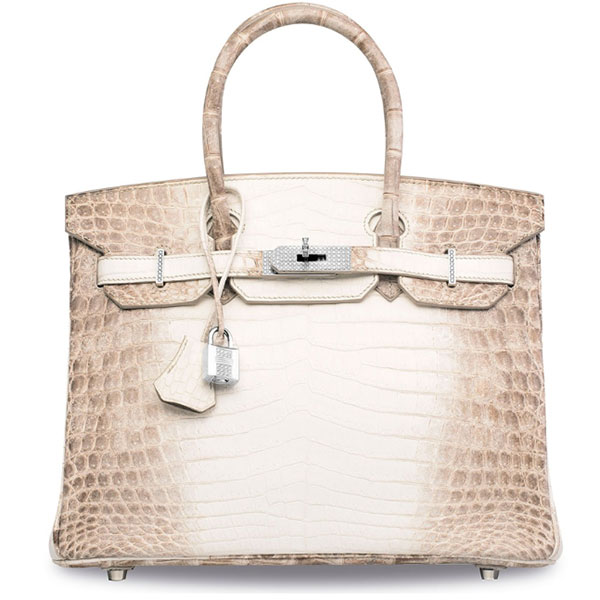
Jewelers often say their biggest competitors aren’t jewelers, but rather makers of other luxury products that compete for consumers’ coveted discretionary dollars. Topping the list are handbags by the likes of Hermès, Chanel, and Louis Vuitton.
Last week, I decided to do a little opposition research. I attended a lecture at Christie’s showroom in Los Angeles given by Caitlin Donovan, U.S. head of the Christie’s handbags and accessories department. Handbags have the dual distinction of being both the house’s newest collector category (they became a stand-alone department in 2014) as well as “the only female-centric department in the entire auction world,” Donovan said.
“Women, young women, are taking this on as their own collecting category,” she said, adding that handbags can fetch anywhere from $500 to $400,000 (!).
In the race to lure millennial self-purchasing women, luxury bags may indeed have the edge over jewelry, which has historically been purchased by men.
The particulars of the market are fascinating. “We like to say that we’re the accessories department, not the Hermès department,” Donovan joked, underscoring an undeniable fact about the category: Seventy percent of the handbags sold at auction are by Hermès, the Parisian luxury goods maker with the storied equine heritage. (The house’s Birkin, Kelly, and Constance bags rule the market, in that order.)
The No. 1 reason why pre-owned Hermès bags are so highly sought after is that the primary market does not hold enough inventory to satisfy demand. Those Birkin waiting lists are no myth.
Here are a few other things I learned from Donovan’s engaging lecture—and what the takeaways are for jewelers.
The secondary market for luxury handbags began to form around 2006 and grew in the wake of the financial crisis.
While this may seem counterintuitive—aren’t luxury accessories the ultimate in frivolous spending?—Donovan said the opposite has proven true. “People said, ‘I want to spend a little more on something that will hold its value,’ ” she said.
Her comment was borne out in May 2017, when a Hermès Birkin Himalaya bag with 10.23 cts. of diamond pavé and 18k white gold hardware sold for $383,522 at Christie’s in Hong Kong, becoming the most expensive handbag ever sold at auction (and validating the Hermès Himalaya’s reputation as the holy grail of handbags).
We’ve seen something similar happen in the jewelry market, where pricey, one-of-a-kind goods have proven more resilient to the economy’s ups and downs than mass-market or even middle-market goods. For one thing, they’re immune to price-shopping. When I speak to jewelry and watch retailers about how they are rethinking their product portfolios, the overarching theme seems to indicate a general shift toward the high end, a tack to capture clients looking for pieces that promise to hold their value.
A rare Hermès Birkin bag is the equivalent of a bauble by JAR, the famously exclusive American jeweler in Paris—with one key exception.
Like all collector categories, Hermès handbags come with a long and esoteric list of factors that determine value. Take, for example, the most highly valued color for bags. According to Donovan, it’s braise, a bright red that’s super hard to find on the primary market (though Mykonos blue is a trendy contender). When it comes to exotic skins, those that come from the porosus crocodile, a saltwater croc farmed in Australia but common to the Indo-Pacific region, reign supreme.
The most in-demand jeweler on the secondary market, however, owns that title due to a less complicated dynamic. First and foremost, his name is Joel Arthur Rosenthal, aka JAR. And what makes his baubles so coveted is not a particular gemstone or motif—it’s the fact that they are simply unavailable on the primary market. To even hope to arrange a meeting, you have to know someone who knows someone who knows someone. And even then, nothing is guaranteed.
Bottom line: If you want to ensure you’re paying a fair price for something on the secondary market, you must do your research. Unless you’re considering a jewel by JAR, in which case you’ll simply have to spend as much money as it takes.
The secondary market determines what’s collectible—thus fueling the primary market.
Although Hermès, like most jewelry and watch brands, does not maintain an official secondary market (by, say, selling pre-owned Birkin and Kelly bags through its own stores—though, never say never!), the firm would be adrift without its secondary channels.
Brands are “only adding to the allure of the primary market by managing the secondary market,” Donovan said.
The jewelry and watch industry has been slow to capitalize on this truism, but over the past year, things have begun to change. In June, the Swiss luxury goods conglomerate Richemont announced a deal to acquire the pre-owned watch site Watchfinder. Websites such as TrueFacet, Crown & Caliber, and The RealReal are gaining a reputation as trusted platforms for both buying and selling. Are independent retailers prepared to meet the needs of clients charmed by what they can find at auction or through online dealers of pre-owned merchandise? The savvy ones are. As for the rest, you’ve got some ’splaining to do.
Top: An exceptional, matte white Himalaya Niloticus Crocodile Birkin 30 with 18k white gold and diamond hardware by Hermès, circa 2014, sold in 2017 for $383,522 at Christie’s Hong Kong
- Subscribe to the JCK News Daily
- Subscribe to the JCK Special Report
- Follow JCK on Instagram: @jckmagazine
- Follow JCK on X: @jckmagazine
- Follow JCK on Facebook: @jckmagazine